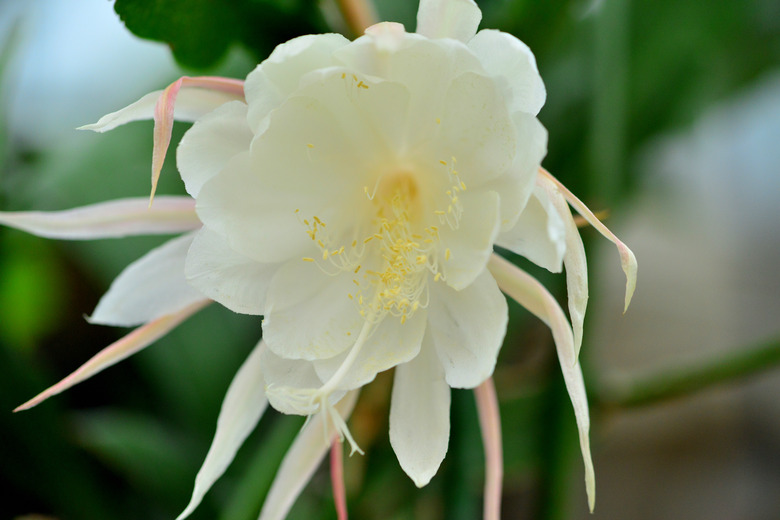How To Take Care Of Night-Blooming Cereus
We may receive a commission on purchases made from links.
The spineless tropical cactus night-blooming cereus (Epiphyllum oxypetalum) produces spiderlike fragrant flowers that open in the evening. It grows in U.S. Department of Agriculture plant hardiness zones 10 through 11 and is intolerant of frost. However, it grows well as a houseplant or as a potted outdoor plant that's overwintered indoors in colder climates. It is also known as the orchid cactus.
Night-blooming cereus is a cactus that requires only basic care, and it is a relatively low-maintenance plant whether grown outdoors or inside. Keep it away from children or pets since the plant parts can be toxic.
Select a Warm, Sunny Location
Select a Warm, Sunny Location
Set potted night-blooming cereus plants in an area that receives all-day, filtered sunlight, bright but indirect sunlight, or morning sun and afternoon shade. Place the plants outdoors if temperatures are above 50 degrees Fahrenheit at night. In warm, frost-free climates, grow the cactus in a well-drained, slightly sandy garden bed that receives some shade.
Remember that this is a plant that loves being warm. Bring potted plants indoors before the temperature drops below 40 degrees in fall or early winter. Temperatures below 35 degrees can kill these plants. Move the pot back outdoors in spring after frost danger has passed.
Water and Feed the Cereus
Water and Feed the Cereus
Water the night-blooming cereus when the soil surface looks dry but before the soil dries out completely. Sprinkle the water on the soil, keeping the cactus leaves dry, until excess water drains from the bottom of the pot or until the top 6 inches of soil feel moist in a garden bed. Water regularly from spring through early fall. Garden-grown and fully mature potted plants don't require winter watering. In water, water young, pot-grown plants only when the soil dries completely. Properly watered cactus plants rarely suffer from stem rot or fungal problems.
Mix 1/4 teaspoon of a balanced, water-soluble fertilizer, such as a 15-15-15 blend, or a bloom-inducing fertilizer, such as a 7-9-5 blend, with 1 gallon of water. Water the night-blooming cereus with the fertilizer solution once weekly during the active spring and summer growing season. Check the label because rates vary among brands and use one-fourth of the recommended concentration.
Care for the Cereus
Care for the Cereus
Watch for mealybugs, which are the primary pest of night-blooming cereus. Inspect the leaves for white cottony masses. Pick off mealybugs by hand or dip a cotton swab in rubbing alcohol and dab it onto the bugs to kill them. Monitor the plant daily and remove or kill any new mealybugs until the pests are gone.
Night-blooming cereus doesn't require annual repotting if it's grown in a larger 1- to 2-foot-diameter container and pruned to manage its height. If you do repot, use a container with bottom drainage holes and a potting mix containing both organic matter and sand or perlite to ensure drainage. Save the leaf stem trimmings when you prune and plant the cut end into a small pot of soil. Night-blooming cereus cuttings root within three weeks if the soil is kept moist, providing you with a supply of new plants.
